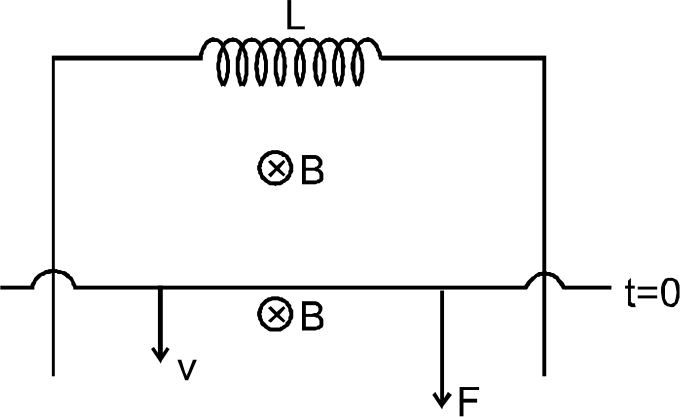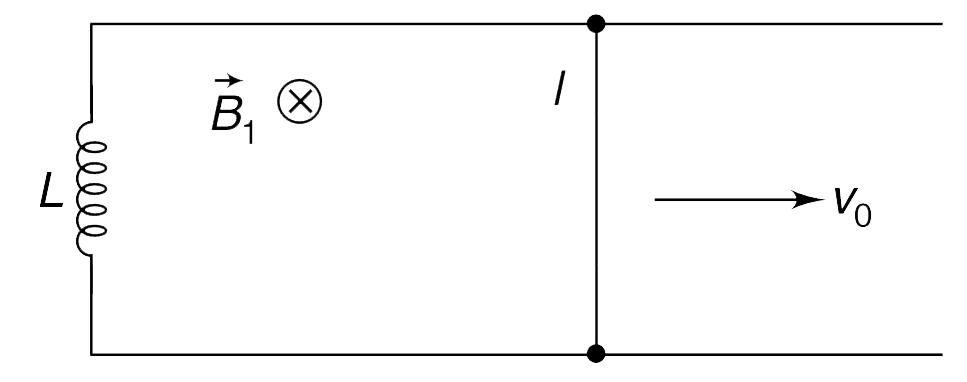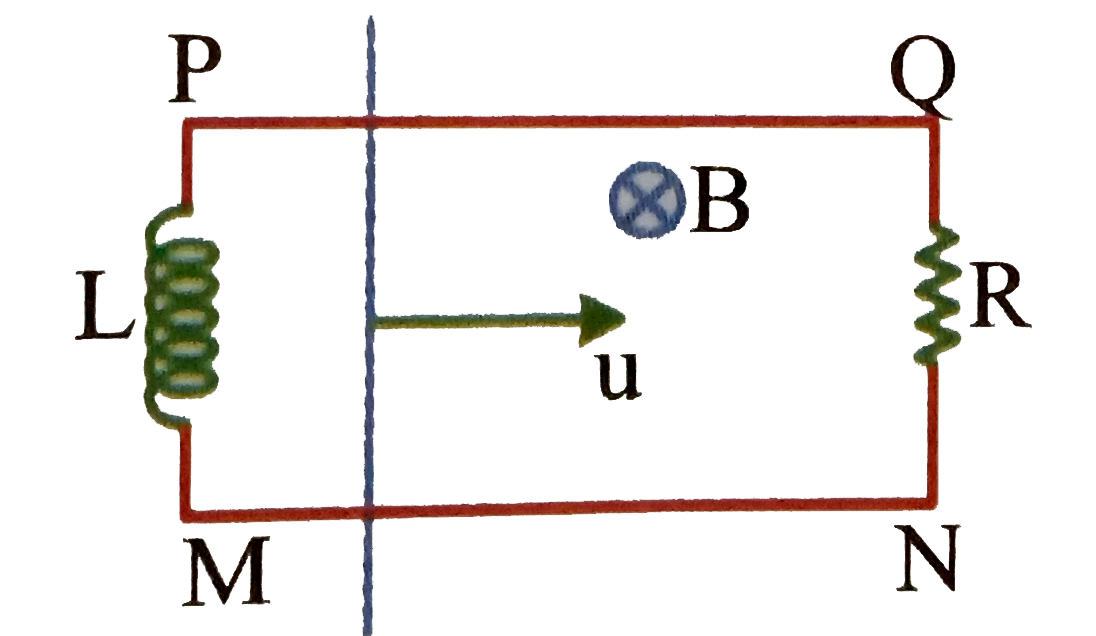As shown in the figure a variable force F is applied on conducting wire of length l such that its velocity remians. There is no resistance in any branch in the circuit. Consider the motion of wire from t=0 initially there is no current in inductor now when wire has covered a distance x (from initial position) Then at that time energy of inductor will be. (Neglect gravity)

independent of x
directly proportional to x
directly propportional to x2
directly proportional to x10
Current in circuit at any time t=(B/vLt)2
t=xv
So, E∝x2
Topper's Solved these Questions
Similar Questions
A radioactive element decays by β−emission. A detector records n beta particles in 2s and in next 2s it records 0.75n beta particles. Find mean life correct to nearest whole number. Given ln |2|=0.6931, ln |3|=1.0986.
View SolutionWhen p−n junction diode is forward biased, then
View SolutionTwo ends of an inductor of inductance L are connected to two parallel conducting wires. A rod of length l and mass m is gien velocity v_0 as shown. The whole sytem is placed in perpendicular magnetic field B. Find the maximum current in the inductor. (Neglect gravity and friction)
View SolutionA rod of length l is kept parallel to a long wire carrying constant current i . It is moving away from the wire with a velocity v.F∈dtheemf∈duced∈thewirewhenitsdistance∈thewirewhenitsdistanceomthelongwireisx.
View SolutionAs shown in the figure a variable force F is applied on conducting wire of length l such that its velocity remians. There is no resistance in any branch in the circuit. Consider the motion of wire from t=0 initially there is no current in inductor now when wire has covered a distance x (from initial position) Then at that time energy of inductor will be. (Neglect gravity)
View SolutionThe resistance of a wire of length l and diameter d is R. The wire is stretched to double its length. The resistance of the wire will now be
View SolutionTwo ends of an inductor of inductance L is connected to two parallel conducting rails. A conducting wire of length (that is equal to separation between the rails) can slide on the rails without friction. The wire has mass m. It is projected with a velocity v0 parallel to the rails (see Figure). Neglect self inductance and resistance of the loop.
(a) Find velocity of the wire as a function of time.
(b) Write current through the wire at time t.
(c) Find speed of the wire as a function of its displacement.
(d) Is the current in the conductor zero when it stops? If no, find this current .
(e) Will the conductor move after it stops?

View SolutionA force F is applied on the wire of radius r and length L and change in the length of wire is l . If the same force F is applied on the wire of the same material and radius 2r and length 2L. Then the change in length of the other wire is
View Solutionकिसी तार कि लम्बाई उसकी प्रारम्भिक लम्बाई कि तीन गुना करने पर उसका प्रतिरोध हो जायगा -
View Solutionकिसी तार की लम्बाई उसकी प्रारम्भिक लम्बाई का तीन गुना करने पर उसका प्रतिरोध हो जायेगा
View SolutionTwo long parallel metallic wires with a resistance 'R' from a horizontal plane . A conducting rod AB is on the wires shown in figure . The space has magnetic field pointing vertically downwards. The rod is given an initial velocity 'v_(0)' . There is no friction in the wire and the rod . After a time 't' the velocity v of the rod will be such that :-
View SolutionIn the figure, a conducting rod of length l=1 meter and mass m=1kg moves with initial velocity u=5m/s. On a fixed horizontal frame containing inductor L=2H and resistance R=1W. PQ and MN are smooth, conducting wires. There is a uniform magnetic field of strength B=1T. Initially there is no current in the inductor. Find the total charge in coulomb, flown through the inductor by the time velocity of rod becomes vf=1m/s and the rod has travelled a distance x=3 meter.

View SolutionThe length of a wire is L, it hangs from a firm body. By applying F force on it, its length increases l. have work
View SolutionTwo ends of an inductor of inductance L are connected to two parallel conducting wires. A rod of length l and mass m is gien velocity v_0 as shown. The whole sytem is placed in perpendicular magnetic field B. Find the maximum current in the inductor. (Neglect gravity and friction)
View SolutionIn the circuit diagram shown, initially there is no energy in the inductor and the capacitor, The switch is closed at t = 0 . Find the current I as a function of time if R=sqrt(L//C)
View SolutionIn the figure shown, a conducting wire PQ of length l=1m, is moved in a uniform magnetic field B=4T with constant velocity v=2m/s towards right. Given R=2Ω,C=1FandL=4H.

Currents through resistor, capacitor and inductor at any time t are l1,I2andI3 respectively. Current through wire PQ is I.
At t=2s,At t=2s, suppose P is the initial power generated by the applied force. P1 the power generated by the applied for, P1 the power stored in magnetic field of inductor and P2 the power dissipated in resistance. The
View Solution
